EOLUS One – Where Creative Minds Come Together
I met Eolus McMillan from Implenia on Second Life yesterday. And, I heard the extraordinary story of how creative minds from different backgrounds, IBM, SAP, Wago, Zumtobel and Implenia amongst others, have come together to make a major leap towards 3D internet. The fruits of this collaboration will be unveiled on July 6th, on Second Life. The picture above shows a birds eye view of EOLUS One on Second Life.
The most important aspect of this breakthrough is the EOLUS focus on Real Life and Second Life interactions that serve to make a better world – addressing many aspects from CO2 Reduction, Energy Management, Health, to Education, Collaboration , Networking, and more.
I hoped that positive global development would be embedded in the DNA of 3D internet. And, almost all my writing in the last few months has been with this in mind. But now, in the work of Eolus McMillan, positive global development and 3D internet have come together.
“I can’t convey just how big this is as a leap towards 3D internet.”
This is how I first heard about EOLUS One from Aleister Kronos. He is first on so many ground breaking stories on Second Life! He talked to Eolus McMillan hours before leaving for vacation in Japan. But, he sent me a condensation of his thoughts before he left. Here are some of them, lightly edited by me.
EOLUS One is a number of things:
A forum or think tank for creative minds looking to explore how SL can help make a better planet (does that tweak your interest? LOL).
A technology solution to integration to back-end systems, using not just SL but any kind of “I/O device” (like Roo controlling his house from his mobile?)
The construction of virtual operations centers to manage the environmental controls of a house/housing estate.
The definition of Virtual Worlds Communication Interface.For me, it was a revelation. I’d stumbled on an IBM site (Boblingen or some such) a long time back, which showed similar operations centers, but Eolus are launching for real next week (6th July) and will have proper integration with RL systems- including an integration with SAP supply chain and CRM systems. I will rephrase that, you will be able to buy stuff in SL, using SL currency, that gets handled by a back-end RL system (here, SAP) that will deliver the goods to your RL address… and you can track the order in SL.
And, then there’s the “better planet” think tank!
My mind started racing at the news. I immediately logged onto Second Life and contacted Eolus McMillan to arrange a meeting. And then, Eolus gave me a teleport to EOLUS One. What follows is what I have learned so far about this wonderful story.
One of the first places Eolus McMillan took me on the EOLUS One island was an art gallery currently showing an exhibition of Eshi Otawara’s real life paintings. Eshi Otawara is a talented Real Life Artist and the 3D Experience Architect for EOLUS One.
I am impressed that Eolus wanted me to see this first. This kind of respect for others and their creative work gives you an idea why Eolus and Ansi have managed to spark the kind of creative collaboration across disciplines and enterprises that any major leap towards 3D internet had to accomplish to succeed.
So lets take a journey through time to find out how the story of EOLUS (which means fast moving/flexible in Greek) began.
EOLUS – The Birth of a Virtual Corporation.
The story of EOLUS One is told visually in a museum on the EOLUS One Island on Second Life. And, there will be an official global press release out soon. As a virtual corporation EOLUS has been able to work faster and more creatively than any real corporation could.
The story began, March, 15th, 2007, at the European Computer expo called CEBIT, when a Paradigm Pioneer, from Implenia Global Solutions (who was soon to become the avatar Eolus McMillan), and Ansi Orochi (Lead Architect, Virtual Worlds, IBM Research and Development) met because they both had a booth at the IBM stand. Eolus McMillan the avatar was born, March 20th, 2007.
The German Chancellor Checks Out The Implenia Model House
At the opening of CEBIT, Implenia got a chance to tell their story to the German Chancellor Angela Merkel. Eolus remarked, “we initially got 4 mins from her people, but she found the story so interesting she stayed for 15 mins. Then Ansi (Lead Architect Virtual Worlds, IBM Research and Development) presented the concept of Virtual Worlds using Second Life to her for a few minutes.
In this picture Angela Merkel the Chancellor of Germany is peering into the Implenia model house. Anette Shavan Minister of Education is on the right behind the house. And, the General Manager of IBM, Germany, Martin Jetter is standing in the back against the backdrop of the IBM banner.
Real Life Mashups
Eolus and his newfound friend Ansi have engineered a paradigm shift, from conception to successful trials of use examples, in three short months. And, the lynch pins of this lightning fast success are two of the most powerful tools for collaborative visualization available to us today – the napkin (typically found at a table with a sympatico mix of creative minds and good wine), and the great virtual napkin of collaboration and innovation (the world scale dinner table where artists, futurists, inventors and uber geeks of all stripes come together) – the think tank for a “better planet” – Second Life.
During one of those late night expo dinners, Eolus and Ansi met and the napkin is drawn. And, they decide to take their vision to reality – building automation components to IBM Websphere to SAP ERP2005 linked to Skype and IP Factory. They also took down some basic ideas for the island on Second Life and defined some simple use cases that would relay the message of how useful Second Life/Real Life interaction can be. Just a few of the many examples shown:
Building Automation
Energy Monitoring
Alert Management
Preventive maintenance
Virtual eshop
Here is the first paper napkin, which I hear still exists.
A Time-line Showing The Trajectory of EOLUS One Over the Last Three Months.
The pictures starting bottom left show the Implenia demo at CEBIT where they showcased their work on intelligent building, advanced metering infrastructure, energy monitoring/management, and facilities management.
The house in the bottom left corner of the picture is a copy of a real life house. Eolus said that sensors, collecting data on energy (e.g. electricity, gas, oil, water) and security plus other relevant data – temperature, humidity, setting of devices, errors that come from devices etc., are installed at his home, office and a large shopping mall in Zurich.
Before CEBIT Implenia had already completed a field test on 35 buildings with a total of 170000 SQM over a period of two years where Eolus says, “we managed to reduce the cost by 34 swissfrancs per sqm per year.”
VWCI – Virtual World Communication Interface
From this meeting at CEBIT other innovators came on board, including a German University student Panini Lane, who wrote his thesis on VWCI. And, EOLUS One, a world changing project, began to evolve. A key part of the EOLUS technology solution is the EOLUS Virtual Worlds Communication Interface (this is a working title).
VWCI is a piece of hardware and software that on one hand solves the problem of ‘talking’ to the various protocols in building automation (LON, KNX, Enocean, ZigBee, CANOpen, Profibus, Modbus…..) and on the other hand links RL buildings to SL to allow for a drastic improvement on facility management processes, reducing the carbon imprint of everything from commercial buildings, individual homes to shopping malls, industrial facilities, and more. VWCI uses IBM’s MQtt messaging protocol and the IBM WebSphere portal in the backend (see my earlier post on IBM Senior Inventor C.J Chowderhead).
Meeting A WebSphere Genius From IBM and an Automation Guru From Wago
And, as Eolus McMillan points out, VWCI is only the enabler. The conditions are defined at a field level e.g. sensor readings, part numbers etc. Then you define a communication path to an object that knows what to do with the information. The information is transfered using a messaging protocol (MQtt) and the database stores it then triggers the action which might result in a transaction in an ERP other external system which would result in a work order being issued.
Hence two other important members of the EOLUS team are a WebSphere Genius from Böblingen, IBM Lab Germany, Hattori Kurosawa, and Sika1972 McMillan a building automation guru from Wago. Both were on EOLUS One when I visited. This picture shows Eolus McMillan, Eshi Otawara (the EOLUS 3D architect), Sika1972 McMillan, and myself.
Eolus and the team are working seamlessly across both worlds. In fact during this meeting in the EOLUS One Control Room he was called to a RL meeting and handed my tour over to 3D Architect and Real Life Artist Eshi Otawara. She kindly took time from her work to show me some of the many features of EOLUS One even though the build will open July 6th. Here is a picture she took during our tour.
Energy Monitoring: A Massive Contribution To Reducing Carbon Footprint
Using EOLUS to indicate when things go wrong before they do!
Eolus described how energy monitoring can drastically reduce the carbon footprint of houses and large facilities. By looking at the state of our systems, we can know when things start to go wrong. People can be doing things wrong in their house, in a large facility, or building management operation for years in, terms of energy management, and not know they are wasting vast amounts of energy.
By tracking the interaction and integration of different systems, e.g., heating, cooling and fuel consumption, energy leaks that cannot be understood from a single data stream can be identified and resolved. The following example of using the EOLUS technology for State of the Art Call Center Managment shows how EOLUS will also enable a much more effective interaction between people and data.
State of the Art Call Center Management
Eolus gave an example of an Alert Management Scenario, and how a control room on Second Life (with 24hr 365 day uptime, of course!) could transform Building Automation Management.
For example, in a traditional Building Automation System, a person would sit in a control room and watch a number of screens that show the state of the various systems. HVAC, Lights, Access Control, Elevators etc. A user might have to monitor a number of buildings and in the information overflow might miss an alert, or might not be fully trained and misunderstand the info, or even worse not have enough practice on certain alert handling issues that only happen ever now and then. These are just some of the many pitfalls of traditional building monitoring.
We are actually drastically expanding the possibilities with what we have in mind here using virtual worlds. We are adding a new dimension.
Let me give you an example. Now Safeway or other large supermarkets have a few thousand stores and a huge number of maintenance staff, some better trained, some less, some know the equipment they work with but they might not know the current configuration, or are out of practice to change a setting.
At present they have a number of screens they must monitor, and often systems are not linked – one system for AC, one for heating, one for the refrigeration, one for the lights, one for this one one for that! The people that know one system within a store might not know how to handle the same system in another store, because there might be new firmware there, or a special setting, or 1 million reasons for that.
Now imagine you had a system that could talk to each device, interface with it and tell it what to do. And then imagine that instead of looking at a monitor in a control room, you simply define a set of rules for certain categories of stores, rules that tell you when interaction is needed, and which information to provide to the maintenance person at the time.
A virtual environment creates new possibilities for data representation and communication, Eolus explained further:
And then think of a rack full of virtual ‘shoe boxes’ each box representing a store, to each box a set of rules attached to it. Depending on the rules set for the store (box) it would indicate its present state in relation to a particular user. In a normal condition the box is green.
And, for example, if the avatar of a technical person approaches the box, they would see the status in regard to the technical rules set for the building(s), a financial person would see the status based on financials (vacancy rate, cost, income, net income, yield, etc.).
New Tools for effective management of work flow :
Now lets assume that one of the rules applies which might mean that a person could be stuck in an elevator which would require immediate attention.
The box would signal that by a change of color, and the dispatcher sitting there would then see which person (avatar) is close to the incident, drop the pic of the avatar on the shoe box and then the backend system, in our case SAP, would initiate a work order and pass the required info to the technician.
He/she would go there fix the issue, give feedback on the incident (mins/hours taken to fix, material needed, persons involved…) by mobile or PDA, and the case would close meaning the box would return to its initial color – green.
Next Generation Building Automation and Much More!
At EOLUS One one of the key challenges was to create and integrate new concepts that would address many of the common issues found in technical facilities management.
Configuration-/ Product Lifecycle Management
Preventive Maintenance
Conditional Monitoring
Training of technical Personnel
Data Representation
These are some of the most interesting aspects of the EOLUS One Initiative. So if you come Friday, July 6th, you will hear lots more about building automation.
There is a virtual model house currently under construction – one on a website (web control panel and image from internet camera), and one in Second Life. They will be fully implemented by July 6th. Then, you can have a little fun controlling the Implenia model house in the real life EOLUS laboratory using one of the virtual Houses, either in Second Life or on the web. Here is the model house on Second Life (currently under construction).
EOLUS working with Spimes and Wranglers
EOLUS is a project all about spimes and wranglers, in my view. The model house, as it has evolved from CEBIT to Second Life, has become more and more spime like. If you know Bruce Sterling’s work or have read, Shaping Things, you are familiar with “spimes” and “wranglers” – technosocial concepts at the core of Sterling’s vision of a shift from archaic forms of energy use and production to a sustainable world. Why do Spimes Matter? Because Spimes Can Save the World. Spimes are:
manufactured objects whose informational support is so overwhelmingly extensive and rich that they are regarded as material instantiations of an immaterial system.
Spimes are visionary concepts – both a thing plus a lot of information about that thing and a technosocial interface. (Biots – another Sterling concept for tomorrow, or rather tomorrows tomorrow, are at the interface of cybernetics, biotechnology, and cognition).
If you think about about things in your life, e.g. your shoes, most of the information is still trapped in the shoe and only accessible through a direct connnection with the shoe, if you lose your shoes you can’t (yet!) in Sterling’s famous opening line “google your shoes.” (see the historian of science and futurist, Alex Soojung-Kim Pang’s blog, The End of Cyberspace. He unpacks some of Sterling’s visionary thought).
But, this current disconnect between objects and information about them is very costly to society not just ‘cos you can’t google your shoes (or keys!) when you lose them. And, the massive energy waste in our homes and other facilities because we lack information about the state and interaction of the systems is just one example of where spimes (like the Implenia model house) can help us make a better world.
And, as Soojung-Kim Pang points out, while spimes aren’t prevalent yet they are coming.
They’ll pose challenges, but we can design around them; “the future is yours to make.” (Sterling)
Spimes must have wranglers. And, in my view, designing wranglers is also what EOLUS is about. A wrangler must crunch the complexities. Their interfaces must make our relationships to objects feel much simpler and more immediate (Sterling).
Bruce Sterling writes:
Real air traffic control systems are grim complex bureaucracies heavy with fail-safes. Who can make objects that integrate elegantly and dependably within an Internet of Things? Who can make that system as relatively simple and inviting as, say, the Internet’s Web browsers and Weblogs? It’s a design space rife with profound opportunity.
And, I guess the ideas of Edward Tufte – dubbed the Leonardo Da Vinci of data will be important here. Tufte is famous for his analysis of the shortcomings of Power Point (see my earlier post) that “disrupts and trivializes,†and whose poverty of information he points out has not only turned business meetings into arenas of excruciating boredom, but contributed to calamities like the Columbia Shuttle disaster in 2003.
And, of course, the brilliant work of Hans Rosling, (see my earlier post and the amazing Gapminder.org videos of Hans Rosling, presented at TED – see TED blog) has changed our relationship to data in profound and world changing ways.
Dealing with world scale development on issues like poverty, global health, or even the rate of growth of a developing world like Second Life, it is very hard to get a handle on events that occur on this kind of massive scale. Hans Rosling (see Gapminder), shows through amazing, animated, interactive statistical analysis how new ways of visualizing data can debunk conventional pessimistic views on beating world poverty – and other major “Myths about Developing Worlds.â€
3D eCommerce
The combination of an interactive 3D environment with a back-end Real Life system (SAP) will open almost limitless new possibilities for people to become active participants in the act of shopping, designing their own products, arranging for the delivery of goods in SL to a RL address… and tracking orders purchased in SL.
On EOLUS One an example of 3D eCommerce has been implemented using the shopping floor and its articles, linked to the backend SAP ERP2005 system to illustrate how the store of the future could look.
Any new visitor will receive a little questionnaire (5 question) when he enters the island. After successfully answering that he will receive a gift voucher with 100 credits. He can step into the gift shop to pick items for those 100 credits , things like a baseball cap, an umbrella…. After he is done with the selection he drops his virtual shopping basket onto the cash register.
A backend process is started, a form is opened, the user enters his RL name and address after which all the info is passed to the SAP system, an order is generated, and the estimated time of delivery will be announced.
There are so called ‘magic boards’ all over the shopping floor, when an avatar comes close to it the current status of his orders will be shown. In the backend the order is placed. The producer of the goods will complete the order have it picked up by a local courier who then updates our backend system with the status of the parcel until it reaches the destination. The user can at any time go to the magic board and find out the details.
Another example:
The picture above was taken on the IBM 10 island where there is an IBM/Sears project for remodeling your own kitchen – you can select appliances, configure panels as you like and much more. If this project was linked to EOLUS each configuration would be a different article number in the back end system and once you were done designing it the way you wanted, you could press the purchase button. The complete configuration then passes the parts to the back end where transaction is being handled in SAP.
I asked Eolus McMillan what was the plan re ID authentication, an important part of making eshopping in virtual worlds viable. Eolus replied that he was in discussion about using products from RSA for strong authentication.
A Creative Context For A Better Planet
The idea of the EOLUS One initiative is to create a platform for creative minds to come to together to evolve the Better Planet theme. On July 6th there will be an opportunity to hear more about this and become part of the vision.
The EOLUS One build is designed to give people the opportunity to engage the different interests they have in Real Life.
For example energy conscious visitors will find areas on EOLUS One devoted to this. But, artists, or educators will also find things to do. Five more islands are planned – one for innovation, one for health care, one for education, one for business, and one for creative arts.
The picture below shows a project that Eolus is working on. SODIS – “a water treatment process used at a household level” – is a project to bring clean water to developing countries. It shows how very simple technologies can often make a big difference. In this case, ordinary plastic bottles are used to remove dangerous bacteria from water by leaving them out in the sunlight for six hours. SODIS, has been organizing funding and support to get this simple technology, and the knowledge of how to use it, to the people who need it. The story of SODIS will be included in an exhibition of projects for a better planet on EOLUS One on Second Life.
Eshi and I both took some pictures during my tour of EOLUS One. Below is a mashup of some of them. The exteriors are Eshi’s pictures the interiors are the ones I took.
July 6th Launch of EOLUS One on Second Life
I just heard from Eolus that Ansi will be at the launch. He has been away on projects, so I did not get a chance to meet him on my tour. Sounds like there will be an opportunity to talk with many members of the EOLUS team this Friday, July 6th.
I was very fortunate to be at the sound check for Jaynine Scarborough who will be performing for the launch. Get ready for a real treat!

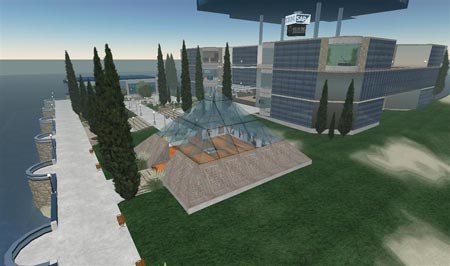
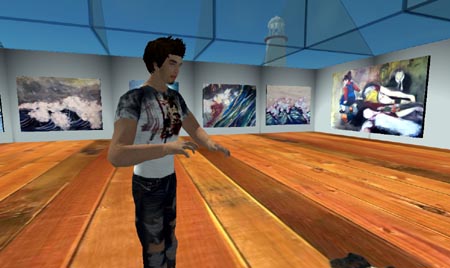
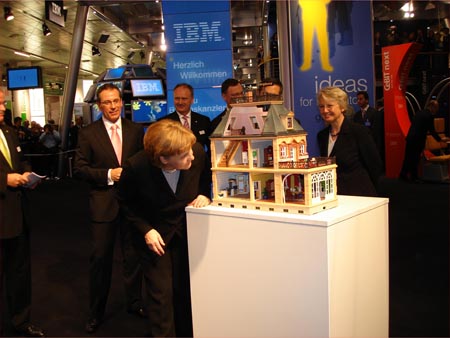
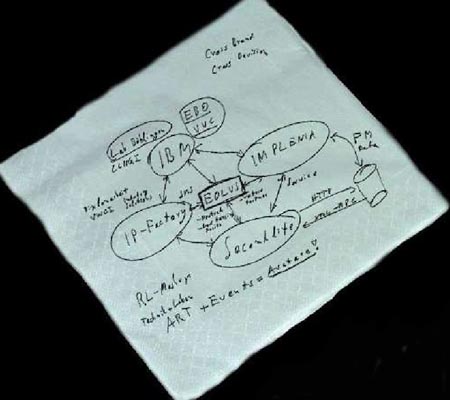
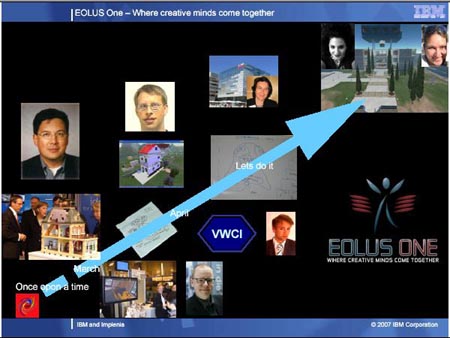
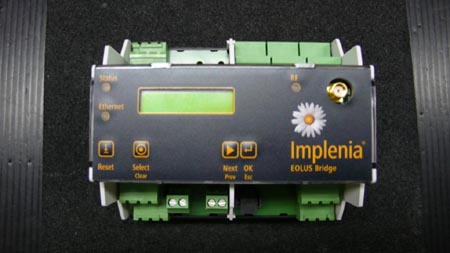
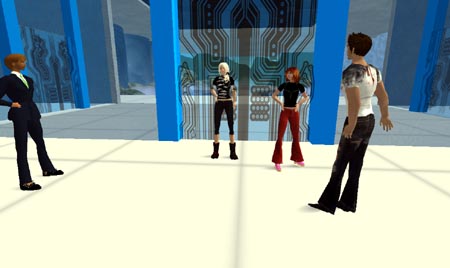
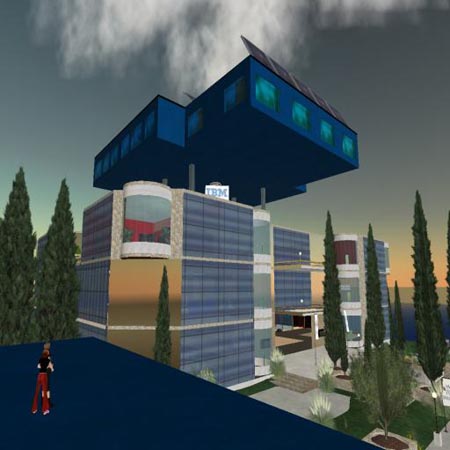
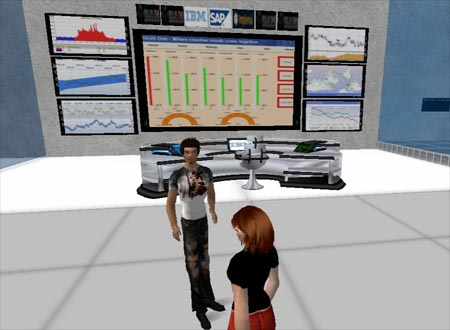
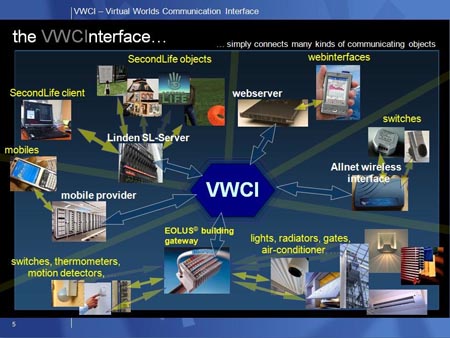
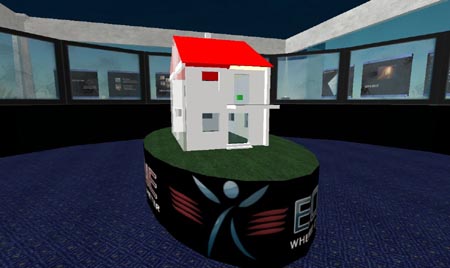
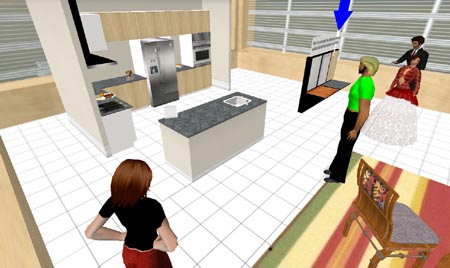
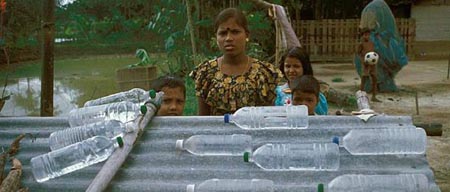
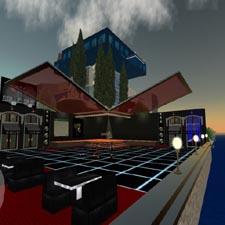
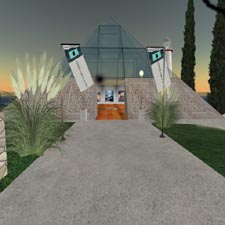
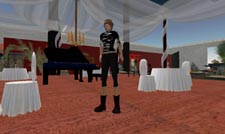
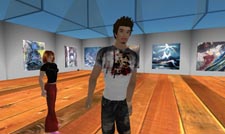
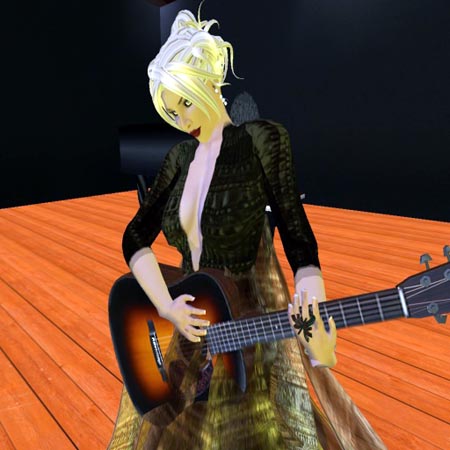
July 5th, 2007 at 3:32 pm
Yes! This is a very informative (great!) write-up… Would love to make the launch on Friday.
July 6th, 2007 at 3:08 pm
Tish – Big. big thanks for picking this up and running with it. There was no way I could do Eolus full justice, even if I had had the time. Having read it once, I now need to go back and re-read your post, there’s so much in it! I’d really like to hear the Hursley guys’ take on this – and Craigster Hax at SAP too.
October 26th, 2007 at 2:17 pm
Hi there. My name is Erica Driver. I am an industry analyst at Forrester Research, where I am working on a report on the topic of getting real work done in virtual worlds. I was wondering if I might have permission to use your photograph of the German chancellor looking at the Implenia dollhouse in one of my reports, to illustrate my brief paragraph about EOLUS One and Implenia (which I first heard about from SAP). I would of course give full attibution in the form of “Source: [Name], [Company Name] or [Web site URL].” I look forward to hearing back from you.
Regards,
Erica Driver, Forrester Research
edriver@forrester.com
August 7th, 2008 at 8:20 pm
Do you think generic domain names with 3d in front or back of them (example http://www.wallstreet3d.com) wold be the next big thing in domain real estate?
December 7th, 2008 at 10:21 pm
Hello
I am a student of University of Richmond. I am currently working on a paper about real-word companies in Second Life. I am just wondering if I can get the permisson from you to use the photo about IBM/Sears in my paper, which will be posted on a public wiki. (www.fall103.pbwiki.com).
Thank you very much
Jun Xie